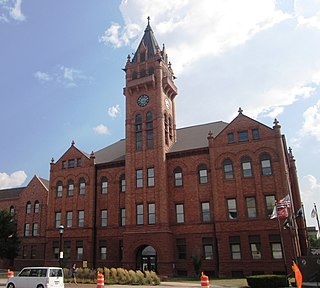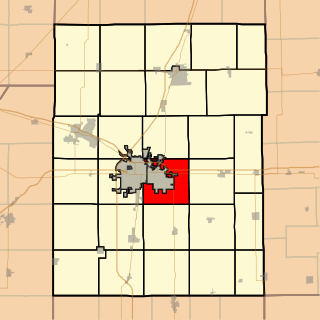
Champaign County is a county in the U.S. state of Illinois. As of the 2020 census, its population was 205,865, making it the 10th-most populous county in Illinois. Its county seat is Urbana.

Champaign is a city in Champaign County, Illinois, United States. The population was 88,302 at the 2020 census. It is the tenth-most populous municipality in Illinois and the fourth most populous city in Illinois outside the Chicago metropolitan area. It is included in the Champaign–Urbana metropolitan area.

Urbana is a city in and the county seat of Champaign County, Illinois, United States. As of the 2020 census, Urbana had a population of 38,336. As of the 2010 United States Census, Urbana is the 38th-most populous municipality in Illinois. It is included in the Champaign–Urbana metropolitan area.

Dwight is a village located mainly in Livingston County, Illinois, with a small portion in Grundy County. The population was 4,032 at the 2020 census. Dwight contains an original stretch of U.S. Route 66, and from 1892 until 2016 continuously used a railroad station designed in 1891 by Henry Ives Cobb. Interstate 55 bypasses the village to the north and west.

Monticello is a city in Piatt County, Illinois, United States. The population was 5,941 at the 2020 census. It is the county seat of Piatt County.

The Champaign–Urbana metropolitan area, also known as Champaign–Urbana and Urbana–Champaign as well as Chambana (colloquially), is a metropolitan area in east-central Illinois. As defined by the Office of Management and Budget (OMB), the metropolitan area has a population of 222,538 as of the 2020 U.S. Census, which ranks it as the 207th largest metropolitan statistical area in the U.S. The area is anchored by the principal cities of Champaign and Urbana, and is home to the University of Illinois Urbana-Champaign, the flagship campus of the University of Illinois system.
Free Frank McWorter was an American born into slavery who bought his own freedom in Kentucky and in 1836 founded the town of New Philadelphia in Illinois; he was the first African American to found a town, and establish a planned community in the United States. The New Philadelphia Town Site was listed on the National Register of Historic Places in 2005 and designated a National Historic Landmark in 2009.

The Lincoln Log Cabin State Historic Site is an 86-acre (0.3 km²) history park located eight miles (13 km) south of Charleston, Illinois, U.S., near the town of Lerna. The centerpiece is a replica of the log cabin built and occupied by Thomas Lincoln, father of U.S. President Abraham Lincoln. Abraham Lincoln never lived here and only occasionally visited, but he provided financial help to the household and, after Thomas died in 1851, Abraham owned and maintained the farm for his stepmother, Sarah Bush Lincoln. The farmstead is operated by the Illinois Historic Preservation Agency.

The New Philadelphia National Historic Site is the original site of the now-vanished town of New Philadelphia, Illinois. It is located near the city of Barry, in Pike County.

Urbana Township is a township in Champaign County, Illinois, USA. As of the 2010 census, its population was 7,451 and it contained 3,435 housing units.

Meadows, Illinois is a small unincorporated community located in McLean County. Meadows is located on US Route 24, midway between Chenoa and Gridley, with easy access from Interstate 55. Meadows at one time had a bank, general store, auto garage, a washing machine factory, and a school. All that remains in town is a nursing home, church, and a grain elevator. One railway line passes through the center of the town.

This is intended to be a complete list of the properties and districts on the National Register of Historic Places in Champaign County, Illinois, United States. Latitude and longitude coordinates are provided for many National Register properties and districts; these locations may be seen together in a map.

Prairie Avenue is a north–south street on the South Side of Chicago, which historically extended from 16th Street in the Near South Side to the city's southern limits and beyond. The street has a rich history from its origins as a major trail for horseback riders and carriages. During the last three decades of the 19th century, a six-block section of the street served as the residence of many of Chicago's elite families and an additional four-block section was also known for grand homes. The upper six-block section includes part of the historic Prairie Avenue District, which was declared a Chicago Landmark and added to the National Register of Historic Places.

The Orpheum Theater opened in Champaign, Illinois in 1914 on the site of a vaudeville theater built in 1904. Designed by the Architectural firm Rapp & Rapp, the Orpheum was built to accommodate both live vaudeville performances and the projection of film. After a series of renovations and changes of ownership, the Orpheum screened its final film in 1986.

Joseph William Royer (1873–1954) was a prolific architect from Urbana, Illinois who designed many prominent buildings in Urbana, Champaign, and beyond. His work included civic, educational, commercial, and residential buildings, many of which are listed in the National Register of Historic Places and feature a wide variety of architectural styles.

The Natural History Building is a historic building on the campus of the University of Illinois at Urbana–Champaign in Urbana, Illinois. Built in 1892, the building originally housed the university's departments of botany, zoology, and geology. In addition to classroom space, the building also included a natural history museum. Architect Nathan Clifford Ricker designed the High Victorian Gothic building. The red brick building has a rough stone foundation and is decorated with colored brick and stone. The steep roof is supported by a timber truss system; the exposed trusses create a coffered ceiling on the interior.

The Main Library is a historic library on the campus of the University of Illinois Urbana-Champaign in Urbana, Illinois. Built in 1924, the library was the third built for the school; it replaced Altgeld Hall, which had become too small for the university's collections. Architect Charles A. Platt designed the Georgian Revival building, one of several on the campus which he designed in the style. The building houses several area libraries, as well as the University Archives and the Rare Book & Manuscript Library. The Main Library is the symbolic face of the University Library, which has the second largest university library collection in the United States.

The Champaign-Decatur CSA, also known as East Central Illinois CSA, is a combined statistical area in the U.S. State of Illinois. It is the 104th largest combined statistical area in the U.S. It is composed of four counties, Champaign, Ford, Piatt and Macon.
William Carbys Zimmerman (1856–1932) was an American architect. He was the Illinois State Architect from 1905 to 1915, designing many state-funded buildings, especially at the University of Illinois. He was a partner of Flanders & Zimmerman.

The Western Union Building, formerly known as the Hagerty Block and currently as the Dacotah Prairie Museum, is a historic bank building in Aberdeen, South Dakota. It is individually listed on the National Register of Historic Places and is a contributing property to the Aberdeen Commercial Historic District.


















